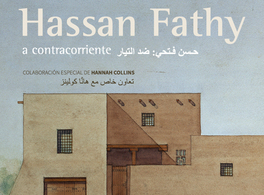Conferences and debates
Index / Activities / Conferences and debates / Conversation with Shahira Mehrez about Hassan Fathy
Conversation with Shahira Mehrez about Hassan Fathy
July 22, 20216:00 p.m.
ONLINE
Casa Árabe’s YouTube channel.
6:00 p.m.
In English, with no translation.
On Thursday, July 22, we will be hosting a dialogue between the Egyptian designer and José Tono Martínez, curator of the exhibition “Hassan Fathy: Against the current” on our YouTube channel.
Also participating is Cándido Creis, cultural attaché of the Spanish Embassy in Cairo. Presented by: Nuria Medina, Casa Árabe’s Culture Coordinator
During the months in which Casa Árabe is hosting the exhibition “Hassan Fathy: Against the current” in its exhibition halls, we will be holding a series of simultaneous events which will give us the chance to get more in-depth knowledge about this ingenious world-renowned Egyptian architect. Along these lines, and at the proposal of the Spanish Embassy in Cairo, we have been fortunate enough to be able to talk with designer Shahira Mehrez, one of the people closest to Hassan Fathy, with whom he shared many important times in his career and personal life. Shahira is welcoming us to her house in Cairo, which was designed by Hassan Fathy himself, and speaks to us with one of the lattices that have been so characteristic of the architect’s work behind her.
Shahira Mehrez (1943) is a well-known designer and essential figure on Egypt’s cultural and intellectual scene. She holds a Master’s degree in Islamic Art and Architecture from the American University in Cairo and has been a graduate researcher at Oxford University, as well as a lecturer at Helwan University’s School of Tourism. Her interest in Egypt’s endangered traditional heritage led her to find new direction in her career, and for the past forty years she has been researching and collecting traditional Egyptian jewelry and costumes, up to now not well documented despite their importance. She is currently preparing a publication with her collections.
Hassan Fathy Hassan Fathy (Alexandria, 1900- Cairo, 1989), known worldwide as “the architect of the poor,” is one of the most exciting figures in the history of contemporary architecture. A scholar, painter, poet and thinker, he was an intellectual who lived through the most important moments in twentieth-century Egypt. He opposed the neo-colonialist idea of attempting to standardize Egyptian culture in accordance with an internationalist scheme. Through his constructive philosophy, he returned to the roots, looking back at the teachings of the traditional peasant, or “fellah,” and the southern Nubian traditions where domes, arches and sloped vaults were still built without buildings frames, as has been done since the dawn of time. Years before our era’s professorships on materials existed, Fathy took notice of the long-known properties of adobe, clays and sands dried in the sun and mixed with straw as a cheaply available construction materials that provide great thermal insulation. This millennia-old tradition has been essential in desert regions, where there are strong differences in temperature between day and night.
During the months in which Casa Árabe is hosting the exhibition “Hassan Fathy: Against the current” in its exhibition halls, we will be holding a series of simultaneous events which will give us the chance to get more in-depth knowledge about this ingenious world-renowned Egyptian architect. Along these lines, and at the proposal of the Spanish Embassy in Cairo, we have been fortunate enough to be able to talk with designer Shahira Mehrez, one of the people closest to Hassan Fathy, with whom he shared many important times in his career and personal life. Shahira is welcoming us to her house in Cairo, which was designed by Hassan Fathy himself, and speaks to us with one of the lattices that have been so characteristic of the architect’s work behind her.
Shahira Mehrez (1943) is a well-known designer and essential figure on Egypt’s cultural and intellectual scene. She holds a Master’s degree in Islamic Art and Architecture from the American University in Cairo and has been a graduate researcher at Oxford University, as well as a lecturer at Helwan University’s School of Tourism. Her interest in Egypt’s endangered traditional heritage led her to find new direction in her career, and for the past forty years she has been researching and collecting traditional Egyptian jewelry and costumes, up to now not well documented despite their importance. She is currently preparing a publication with her collections.
Hassan Fathy Hassan Fathy (Alexandria, 1900- Cairo, 1989), known worldwide as “the architect of the poor,” is one of the most exciting figures in the history of contemporary architecture. A scholar, painter, poet and thinker, he was an intellectual who lived through the most important moments in twentieth-century Egypt. He opposed the neo-colonialist idea of attempting to standardize Egyptian culture in accordance with an internationalist scheme. Through his constructive philosophy, he returned to the roots, looking back at the teachings of the traditional peasant, or “fellah,” and the southern Nubian traditions where domes, arches and sloped vaults were still built without buildings frames, as has been done since the dawn of time. Years before our era’s professorships on materials existed, Fathy took notice of the long-known properties of adobe, clays and sands dried in the sun and mixed with straw as a cheaply available construction materials that provide great thermal insulation. This millennia-old tradition has been essential in desert regions, where there are strong differences in temperature between day and night.


